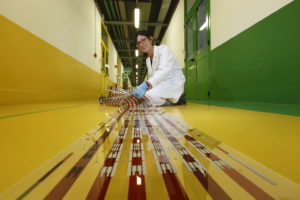A Custom-made Solar Panel: the OPV Technology

eniday.com
Article by Francesca Marasciuolo
Speaking about the solar panels, we always think about the Silicon ones, which are the most widespread in commerce. However, this technology has some disadvantages, like for example the cost to produce this kind of complex panel (the complex process consists of producing a crystal of Silicon with a suitable purity and the following doped of it) and the removal costs.
In this new field the researchers of the Eni Research Center for the Renewable Energy and the Environment have studied the new OPV technology (Organic PhotoVoltaics): it means organic solar panels made of polymer and organic molecules, without using the Silicon. This technology has some interesting advantages:
- Low material usage: with 1 kg of polymer we can cover a wide area like a football field ;
- The technologies used to lay down the cells are very easy and with a low usage of energy, instead of the ones used in the Silicon technology. These technologies consists of the printing Roll to Roll ones that are commonly used in the paper industry;
- The devices are printed on a plastic substratum, so they are light and flexible, while the silicon panels are heavy and stiff;
- The flexibility makes the devices able to conform to the characteristics of the final application: we can do a custom-made printing;
- Good performances in scattered light conditions: in the Building Integration field this photovoltaic modules could be placed on vertical facades or on the southern ones. They are not usually used for the application of silicon modules.

However the OPV technology has a lower efficiency than the silicon one, but the OPV panels also work in scattered light, instead of the silicon ones. In this way energy can be produced at dawn, at sunset, when it is cloudy, no matter of the orientation of the panels following the Sun.
Moreover, the Eni Research Center studies a possible integration of these modules to sensors in an elecrtic system, following the idea of Internet Of Things. It consists of a grid with sensors that pick up data and communicate each other. In this case the panels could provide energy to the sensors and send data, so the system becomes less complex without electric cables.
This study will definitely shake up not only the photovoltaic market but also the energy one, towards a green future.
Read more HERE.
